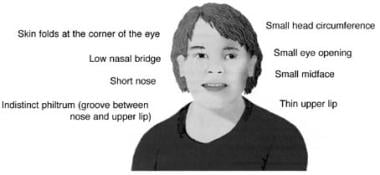Background
Adverse fetal, neonatal, and pediatric effects occur with maternal alcohol consumption during pregnancy. The diagnosis of fetal alcohol syndrome (FAS) is based on findings in the following 3 areas: (1) characteristic facial anomalies (see image below), (2) growth retardation (intrauterine growth restriction and failure to have catch-up growth), and (3) CNS involvement (cognitive impairment, learning disabilities, or behavioral abnormalities).
Facial characteristics of a child with fetal alcohol syndrome.
Prenatal exposure to alcohol is associated with a variable spectrum of effects referred to as fetal alcohol spectrum disorders (FASD), with fetal alcohol syndrome at the most severe end of that spectrum. Children with fetal alcohol syndrome disorder may have clinically significant CNS involvement but few or no characteristic physical features.
Lemoine et al first described the pattern of malformation associated with heavy prenatal alcohol exposure in France in 1968, and Jones and Smith first described it in the United States in 1973.
Prenatal alcohol exposure is of substantial public health concern for the following reasons: (1) FAS is the leading known cause of mental retardation, (2) fetal alcohol syndrome or fetal alcohol syndrome disorder is associated with persistent physical and neurodevelopmental abnormalities,
and (3) fetal alcohol syndrome disorder crosses all socioeconomic groups and affects all races and ethnicities. The costs for 1 child with fetal alcohol syndrome are estimated to be $2 million over a lifetime, and costs of fetal alcohol syndrome to the American taxpayer are more than $321 million each year.

